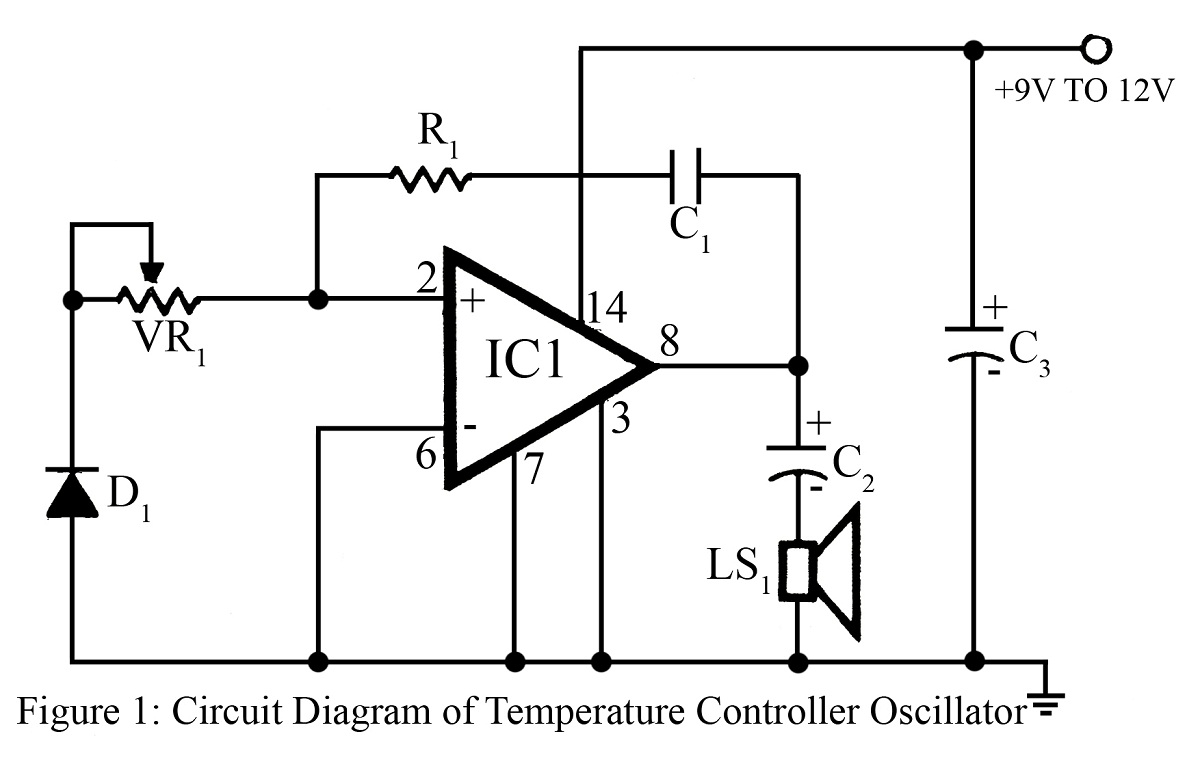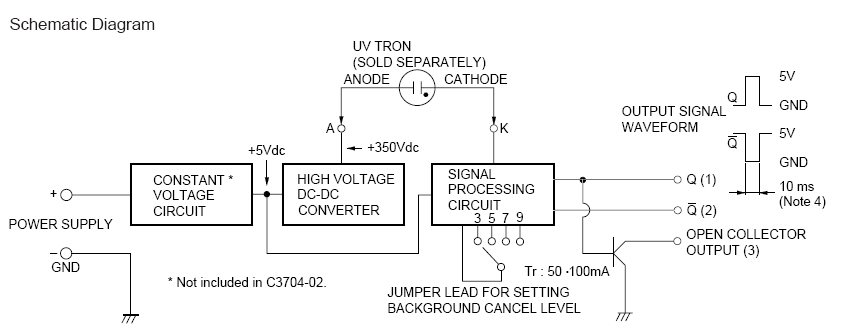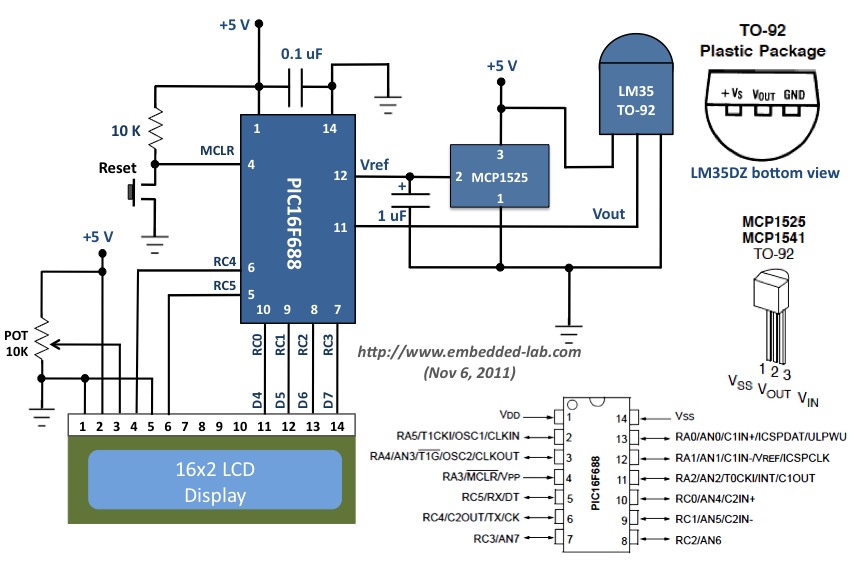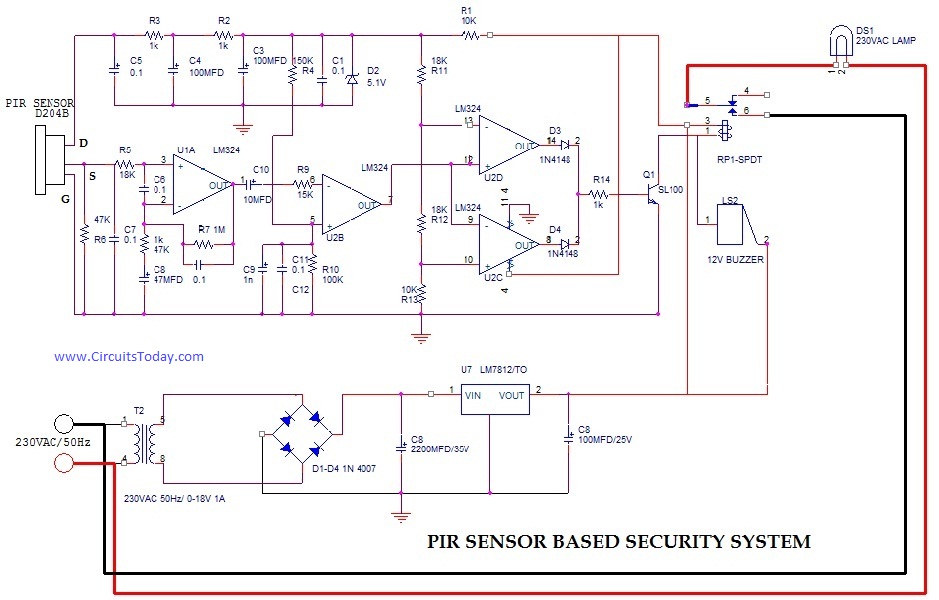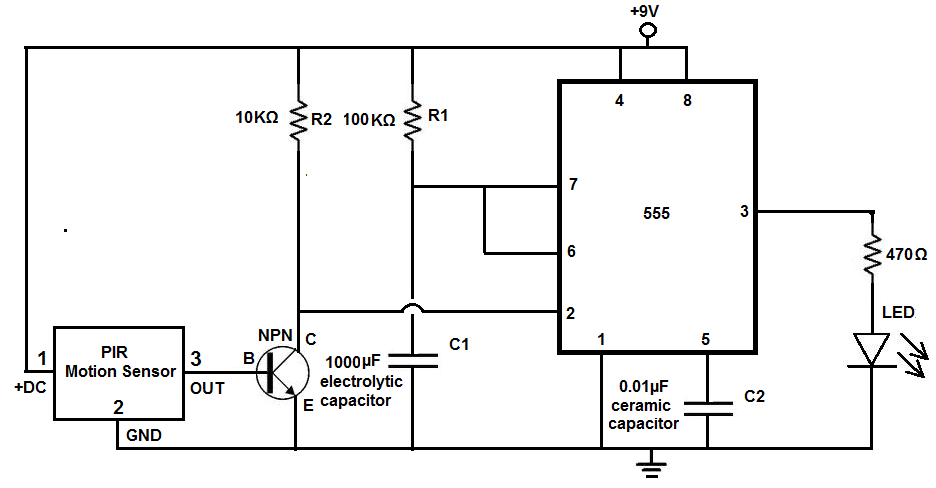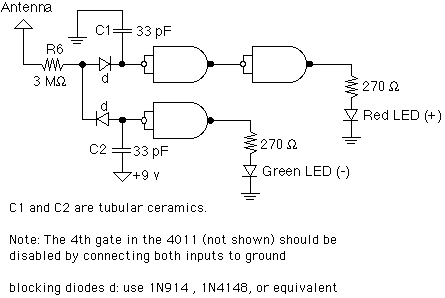
Temperature Sensor
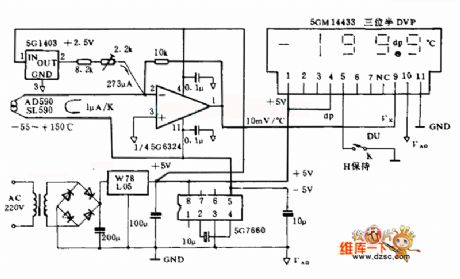
The LM35 temperature sensor provides an output of 10 mV/°C for every degree Celsius over 0°C. At 20°C, the output voltage is 20 x 10 = 200 mV. The circuit consumes 60 µA. The load resistance should not be less than 5 kΩ. A 4- to 20-V supply can be used. The circuit shown includes a digital temperature meter that utilizes a temperature-sensitive diode as the temperature measurement element. It mainly consists of an A/D converter (7107), an operational amplifier (LM324), a 3-digit LED display circuit, and a temperature-sensitive diode. It features high accuracy, good stability, versatility, and ease of use. Its temperature measurement range is from 0°C to 100°C with an accuracy of ±1°C. The voltage follower, constructed from operational amplifier A1, supplies power to the A/D converter integrated circuit (IC2) and the temperature sampling circuit separately to minimize interaction between them. The semiconductor transistor (VT1) along with resistors (R1, R2, R3) provides stable bias current for the temperature-sensitive diode (VD1). The circuit's output voltage (Vo) has a temperature sensitivity of 10 mV/°C. The resistor (R) serves as a current-limiting resistance, while the capacitor (C) enhances circuit stability. When the measurement and reading locations are distant, the voltage drop across the wire resistance may introduce measurement errors. The resistors used in the circuit are metal film types, which offer an accuracy better than 1% and a temperature coefficient (TC) of less than ±50 x 10^-6/K. The measuring range extends from 0°C to 100°C. The current (I) can be calculated as 4 + T/6.25, where the temperature unit is °C and the current unit is mA. The current indicates a KTY87 two-wire current transmitter consisting of a Wheatstone bridge with a pre-amplifier, current transmitter stage, and voltage regulator. The circuit also illustrates a thermocouple input circuit with two temperature zones and diode cold junction compensation. This configuration employs a J-type thermocouple as the temperature sensor, using a semiconductor diode (D) for cold junction temperature compensation to establish a relative 0°C reference point for measurement. The temperature range for T1 is from 0°C to 1000°C, while T2 corresponds to the temperature (TD) of the semiconductor diode (D). As the measured temperature varies from 0°C to 1000°C, the J-type thermocouple generates a 58 mV change. At an ambient temperature of +25°C, the typical output is 1.28 mV, with a corresponding transmission current of 4 mA at 0°C and 20 mA at 1000°C. The temperature difference between two points is often measured in various applications, such as in water pump fan designs, where the impeller shape is determined by the temperature difference between the inlet and outlet. A high sensitivity temperature measurement circuit with 100 mV/°C sensitivity is illustrated. The precision operational amplifier (LM308) amplifies the differential temperature voltage measured by the two sensors by a factor of ten. The output of the operational amplifier is adjusted to zero by varying resistor (Rw) when both sensors are at the same temperature. Additionally, a digital thermometer circuit is composed of SL590, a new semiconductor IC temperature-sensitive sensor, and three half-digital voltage panels (5GM14433). This circuit can measure temperatures in the range of -55°C to +150°C. The SL590 converts the temperature into a current signal, which is then transformed into a voltage signal corresponding to Celsius temperature after null point displacement by an operational amplifier. This voltage is sent to the UX input terminal of the 5GM14433, which displays the digital quantity via an LED. The circuit can be powered by either direct current (DC) or alternating current (AC) supplied by 220V, or alternatively by four 1.5V batteries.
The LM35 temperature sensor is a precision device widely used for temperature monitoring applications. It outputs a linear voltage proportional to the temperature in degrees Celsius, making it suitable for interfacing with various electronic systems. The operational amplifier (LM324) in the circuit serves multiple roles, including signal amplification and buffering, ensuring that the A/D converter receives a stable input for accurate digital representation of temperature readings.
The A/D converter (7107) is crucial for converting the analog voltage signal from the LM35 into a digital format that can be displayed on the LED display. The careful selection of components, such as the metal film resistors, ensures minimal drift and high accuracy, which is essential for applications requiring precise temperature measurements.
The temperature-sensitive diode used in the circuit provides an alternative method for temperature measurement, functioning effectively in conjunction with the A/D converter. This configuration allows for cold junction compensation, which is vital in thermocouple applications to maintain accuracy across varying ambient temperatures.
The digital thermometer's ability to operate over a wide range of temperatures, from -55°C to +150°C, showcases its versatility in different environments. The integration of a semiconductor IC sensor (SL590) enhances the circuit's performance by simplifying the conversion process and reducing component count.
Overall, this electronic schematic represents a sophisticated approach to temperature measurement, combining various technologies to achieve high accuracy, stability, and ease of use in diverse applications.The LM35 temperature sensor provides an output of 10 mV/ƒ for every degree Celsius over 0ƒ. At 20ƒ the output voltage is 20 x 10 = 200 mV. The circuit consurnes 60 A. The load resistance should not be less than 5 k ©. A 4- to 20-V supply can be used. (View) The circuit shown in the picture is the digital temperature meter circuit which us es temperature-sensitive diode as the temperature-measurement element. It is mainly made up of the A/D converter 7107, operational amplifier LM324, 3-digit LED display circuit and temperature-sensitive diode and so on. It features high accuracy, good stability, versatility, ease of use and so on. Its temperature measurement range is 0ƒ~100ƒ with accuracy ±1ƒ. The voltage follower, which is made up of the operational amplifier A1, supply power for the A/D converter integrated circuit IC2 and the temperature sampling circuit separately to reduce the interaction between them.
The semiconductor transistor VT1 and R1, R2, R3 supply stable bias current for the temperature-sensitive diode VD1. (View) This circuit`s output voltage Vo`s temeratrue sensitivity is 10mV/ °C. The resistance R is current-limit resistance. The capacitor C is used to improve the stability of the circuit. When the test position and the result-reading position have a far distance, the wire resistance`s voltage drop would cause some extent measuring errors.
(View) The resistance in the cirtuit is metal film one. Itsaccuracy is better than 1% and temperature coefficient TCis less than ±50X10-6/K. The measuring range is from0ƒ to 100ƒ. Current I= 4+T/6. 25. The temperate unit is ƒ and the current unit is mA. The current shows KTY87two-wire current transmitter consisting of Wheatstone bridge with pre-amplifier, current transmitter stage and voltage regulator. (View) The circuit shows the thermocouple input circuit withtwo temperature zones and diode cold junction compensation.
This circuit uses J-type thermocouple as temperature sensor, semiconductor diode Das cold junction temperature compensation to form the relative 0oC of the measurement, to measure the temperature, T1 temperature range is from 0 to 1000oC. The temperature of T2 is equal to the temperature TD of semiconductor diode D. When the measured temperature changes in the range of 0to 1000oC, J-type thermocouple will have a 58mV change.
When the ambient temperature is +25oC, the typical value would be 1. 28mV. Corresponding 0oC transmission current is 4mA, corresponding 1000oC transmission current is 20mA. (View) The temperature difference between two points is often measured in many situations. For example, in water pump fan design and other designs, the impeller shape is always detemined by the temperature difference between the entrance and exit. if the difference is small, it requires high precision phase resolution. Figure 8 shows a high sensitivity temperature measurement circuit with 100mV / ƒ sensitivity. The precision op amp LM308 ouput 10 times of the differential temperature voltage the two temperature sensors measured.
The Op amp output will be 0 by adjust the Rw when the two sensors are in the same temperature. (View) This digital thermometer electrocircuit is composed of SL590, a new semiconductor IC temperature-sensitive sensor and three half digital voltage panel 5GM14433, and it can measure the temperature in the range of -55~15o ƒ. The SL590 make the temperature be a type of current semaphore, which become ratio`s voltage semaphore at Celsius temperature after making the null point displacement by operational amplifier, and sent to the UX input terminal of 5GM14433, then be digital quantity displayed by LED.
The supply is d. c two types, and alternating current supplyed by 220V, also could be supplyed by 4 pieces of 1. 5V batteries. (View) This digital thermometer electrocircuit is composed of SL616, a newsemiconductor IC temperature-sensitive sensor and three half digital voltage panel(DVP 🔗 External reference
The LM35 temperature sensor is a precision device widely used for temperature monitoring applications. It outputs a linear voltage proportional to the temperature in degrees Celsius, making it suitable for interfacing with various electronic systems. The operational amplifier (LM324) in the circuit serves multiple roles, including signal amplification and buffering, ensuring that the A/D converter receives a stable input for accurate digital representation of temperature readings.
The A/D converter (7107) is crucial for converting the analog voltage signal from the LM35 into a digital format that can be displayed on the LED display. The careful selection of components, such as the metal film resistors, ensures minimal drift and high accuracy, which is essential for applications requiring precise temperature measurements.
The temperature-sensitive diode used in the circuit provides an alternative method for temperature measurement, functioning effectively in conjunction with the A/D converter. This configuration allows for cold junction compensation, which is vital in thermocouple applications to maintain accuracy across varying ambient temperatures.
The digital thermometer's ability to operate over a wide range of temperatures, from -55°C to +150°C, showcases its versatility in different environments. The integration of a semiconductor IC sensor (SL590) enhances the circuit's performance by simplifying the conversion process and reducing component count.
Overall, this electronic schematic represents a sophisticated approach to temperature measurement, combining various technologies to achieve high accuracy, stability, and ease of use in diverse applications.The LM35 temperature sensor provides an output of 10 mV/ƒ for every degree Celsius over 0ƒ. At 20ƒ the output voltage is 20 x 10 = 200 mV. The circuit consurnes 60 A. The load resistance should not be less than 5 k ©. A 4- to 20-V supply can be used. (View) The circuit shown in the picture is the digital temperature meter circuit which us es temperature-sensitive diode as the temperature-measurement element. It is mainly made up of the A/D converter 7107, operational amplifier LM324, 3-digit LED display circuit and temperature-sensitive diode and so on. It features high accuracy, good stability, versatility, ease of use and so on. Its temperature measurement range is 0ƒ~100ƒ with accuracy ±1ƒ. The voltage follower, which is made up of the operational amplifier A1, supply power for the A/D converter integrated circuit IC2 and the temperature sampling circuit separately to reduce the interaction between them.
The semiconductor transistor VT1 and R1, R2, R3 supply stable bias current for the temperature-sensitive diode VD1. (View) This circuit`s output voltage Vo`s temeratrue sensitivity is 10mV/ °C. The resistance R is current-limit resistance. The capacitor C is used to improve the stability of the circuit. When the test position and the result-reading position have a far distance, the wire resistance`s voltage drop would cause some extent measuring errors.
(View) The resistance in the cirtuit is metal film one. Itsaccuracy is better than 1% and temperature coefficient TCis less than ±50X10-6/K. The measuring range is from0ƒ to 100ƒ. Current I= 4+T/6. 25. The temperate unit is ƒ and the current unit is mA. The current shows KTY87two-wire current transmitter consisting of Wheatstone bridge with pre-amplifier, current transmitter stage and voltage regulator. (View) The circuit shows the thermocouple input circuit withtwo temperature zones and diode cold junction compensation.
This circuit uses J-type thermocouple as temperature sensor, semiconductor diode Das cold junction temperature compensation to form the relative 0oC of the measurement, to measure the temperature, T1 temperature range is from 0 to 1000oC. The temperature of T2 is equal to the temperature TD of semiconductor diode D. When the measured temperature changes in the range of 0to 1000oC, J-type thermocouple will have a 58mV change.
When the ambient temperature is +25oC, the typical value would be 1. 28mV. Corresponding 0oC transmission current is 4mA, corresponding 1000oC transmission current is 20mA. (View) The temperature difference between two points is often measured in many situations. For example, in water pump fan design and other designs, the impeller shape is always detemined by the temperature difference between the entrance and exit. if the difference is small, it requires high precision phase resolution. Figure 8 shows a high sensitivity temperature measurement circuit with 100mV / ƒ sensitivity. The precision op amp LM308 ouput 10 times of the differential temperature voltage the two temperature sensors measured.
The Op amp output will be 0 by adjust the Rw when the two sensors are in the same temperature. (View) This digital thermometer electrocircuit is composed of SL590, a new semiconductor IC temperature-sensitive sensor and three half digital voltage panel 5GM14433, and it can measure the temperature in the range of -55~15o ƒ. The SL590 make the temperature be a type of current semaphore, which become ratio`s voltage semaphore at Celsius temperature after making the null point displacement by operational amplifier, and sent to the UX input terminal of 5GM14433, then be digital quantity displayed by LED.
The supply is d. c two types, and alternating current supplyed by 220V, also could be supplyed by 4 pieces of 1. 5V batteries. (View) This digital thermometer electrocircuit is composed of SL616, a newsemiconductor IC temperature-sensitive sensor and three half digital voltage panel(DVP 🔗 External reference
